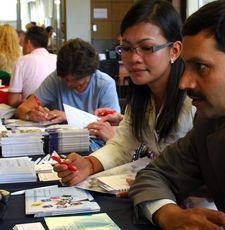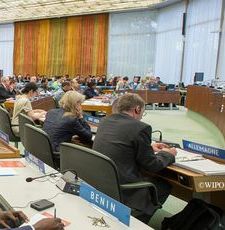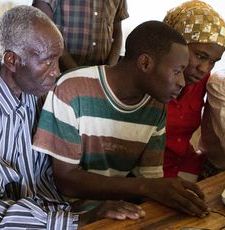
The European Orphan Works Directive: An EIFL Guide
European Orphan Works Directive - an EIFL webinar (December 2013)
Slides and recording available
In October 2012, Directive 2012/28/EU on certain permitted uses of orphan works (known as the orphan works Directive) was adopted by Member States of the European Union (EU). The Directive sets out common rules for the digitization and online display of orphan works. Unfortunately hopes that the Directive would enable large-scale digitization of orphan works by libraries, and enable the works to be made available online for educational and cultural purposes, were not realized. Libraries in EU Member States must wait until the review in 2015 to seek improvements.
This Guide sets out the background and key provisions of the Directive. It makes recommendations for libraries for implementation in EIFL partner countries that are members of the EU, and advises libraries in EIFL partner countries with EU bilateral agreements on crafting solutions that best meet their local circumstances and capacity.
The full text of the Directive can be read here.
Browse the guide online or download [PDF].
I. What are orphan works?
II. The orphan works problem
III. The orphan works Directive (Directive 2012/28/EU)
IV. Key Provisions of the Directive
V. Problems with the Directive
VI. Countries bound by the Directive: advantageous implementations
VII. Countries with EU bilateral agreements
I. What are orphan works?
A work is described as an ‘orphan work’ if it is in copyright, and if the holder of the copyright cannot be identified, or cannot be found. It can be difficult and costly to trace the rightholder because:
- the author may be unknown, or may be deceased leaving no locatable heirs;
- where a publisher or institution holds the rights, it may have ceased to exist with no legal successor, or it may have merged with another entity - the records about copyright ownership may be lost;
- the work may include within it other works, such as photographs or diagrams (called embedded works) with their own separate rights, one or more of which may be orphaned.
II. The orphan works problem
Orphan works have become a problem anyone who wants to re-use in-copyright works1 for several reasons:
- Copyright protection is automatic from the moment that a work is written down. There are no requirements for the author to register the copyright or to notify any authority.2
- Progressive extension of copyright terms make it more difficult to identify and locate rightholders in the future. Copyright protection in a literary work for an author typically lasts for about 120 years.3
- Technological advances mean that more creative content than ever before is available online for discovery and re-use – books, blogs, articles, reports, videos, photos, music.
The problem of orphan works affects contemporary materials as well as older works, especially for online content that has no rights information or metadata identifying the rightholder.
Libraries hold tens of millions of works in their collections of high historical, social and educational value containing materials both in-copyright and in the public domain, published and unpublished, in-print and out-of-commerce.
Many published works have a short economic life because of the nature of the work, but are of enduring high value to historians, scholars and creators. For example: children’s storybooks that become old-fashioned; out-of-date political analysis of events; manuals for working people when the kind of work has changed, such as a handbook written in 1920 for domestic servants.
Technological developments have enabled libraries to provide access to their holdings in new and engaging ways for the benefit of citizens and society through digitizing their collections. Because copyright exceptions are not usually sufficient, permission from the rightholder is often required. However, the problem of orphan works means that time-consuming and costly enquiries are needed to identify and find rightholders in searches that are often fruitless.
‘Indeed, depending on the sector concerned, estimates of the number of orphan works in cultural institutions vary from around 20% for films and slightly less for books, at the low end, to up to 90% for photography at the high end. That is a truly staggering figure, which shows up one of the massive difficulties in applying theory of copyright in practice.
The British library estimates that 40% of works in their collections are orphan and over 1 million hours of TV programmes from BBC archives are not used due to the impossibility or the disproportionate cost to trace rightholders – and the risk of a subsequent legal action is simply too great for this material to be made available online'. Neelie Kroes, European Commissioner for Digital Agenda
Even where orphan works provide valuable resources for scholarship, the transaction costs involved in obtaining permission may be too high, or the risks of litigation too great for the library to undertake the task. Governments, legal scholars, librarians and rightholders recognize that it is not in the public interest for so many works to be locked away from public use.
‘At 4 hours per book it would take one researcher over 1,000 years to clear the rights in just 500,000 books – a drop in the ocean when compared to the rich collections of Europe’s cultural institutions’. Seeking New Landscapes. A rights clearance study in the context of mass digitisation of 140 books published between 1870 and 2010. Barbara Stratton (2011)
‘These [orphan] works raise particular difficulties in the context of mass digitisation. Libraries and archives seek to digitise collections, and have the technological capacity to do so and to provide access to them for users, but they are unable to act where rights holders cannot be found for some of the works, because to digitise those works could be a copyright infringement. The issue is exacerbated in that where rights information is lacking, it is often not even clear whether works are still in copyright or not’. Digital Opportunity. A Review of Intellectual Property and Growth. Hargreaves (2011)
III. The orphan works Directive (Directive 2012/28/EU)
A Directive - one type of Community legislation - requires EU Member States to transpose the content of the Directive into national law, usually by amending national law. Member States have a certain amount of time in which to implement a Directive (in this case by 29 October 2014) and it is reviewed after a certain amount of time (in this case one year, with annual reviews thereafter). Directives are enforced by the European Commission, and if deemed to be incorrectly implemented, Member States can be brought before the European Court of Justice and may be subject to fines.
Recognizing the growing problem of orphan works in the dissemination of Europe’s cultural heritage, the European Union decided to legislate to permit the use of orphan works in special circumstances. Ideally, the Directive would enable libraries to undertake large-scale digitization of interesting works whose rightholders cannot be traced, and make the works available on the public internet for educational and cultural purposes. Unfortunately the Directive will do little to facilitate this outcome.
IV. Key Provisions of the Directive
- Introductory Material (Recitals)
- Subject matter and scope (Article 1)
- Definition of orphan work (Article 2)
- Diligent search and record keeping (Article 3)
- Orphan work status, permitted uses and compensation (Articles 4-6)
- Technical Provisions (Articles 7-12)
- List of sources required for a diligent search [Annex]
Introductory Material (Recitals)
The Orphan Works Directive contains 25 Recitals that help in the interpretation of the Articles. Recital 1 acknowledges the benefits of large-scale digitization and the creation of European Digital Libraries. Recital 5 recognizes that mass digitization is a means of protecting Europe’s cultural heritage. The objective of the Directive, namely ensuring legal certainty with respect to the use of orphan works, is stated in Recital 25.
The Directive applies to certain uses of certain categories of orphan work by certain institutions.
Article 1 sets out the institutions included within its scope i.e. publicly accessible libraries, educational establishments and museums, as well as by archives, film or audio heritage institutions and public-service broadcasting organizations, established in the Member States, in order to achieve aims related to their public-interest missions.
This Guide will refer collectively to ‘Knowledge and Cultural Heritage Institutions” (excluding public-service broadcasting organizations, and it does not deal with the special arrangements for them in the Directive).
The Directive applies to the following categories of works:
- published written works, that are first published in a Member State, held in Knowledge and Cultural Heritage Institutions
- cinematographic or audiovisual works and phonograms (sound recordings) held in Knowledge and Cultural Heritage Institutions
- works of the kinds mentioned in (a) and (b) above that are unpublished, which have been publicly accessible in a Knowledge and Cultural Heritage Institution with the consent of the rightholders, provided that it is reasonable to assume that the rightholders would not oppose the use of the work according to the permitted uses of the work (Article 6).
Member States have the option to restrict category (c) still further by limiting it to unpublished works which have been deposited with the Knowledge and Cultural Heritage Institution before 29 October 2014. In other words, unpublished works deposited in future might be excluded from the scope of the Directive.
A very important provision concerns works which are ‘embedded or incorporated in, or constitute an integral part’ of another work, for example, illustrations in a printed book, or sequences of music in a cinema film. Embedded works may not be disregarded and must be treated as works in their own right (whether or not they too are orphan works).
Article 2 defines a work as orphan if none of its rightholders can be identified or, even if one or more of them is identified, none is located after a ‘diligent search’ is carried out. Where there is more than one rightholder in a work, and not all of them have been identified or located, the work may be used provided that the rightholder(s) located have given their permission.
Diligent search and record keeping
Article 3 defines the important concept of ‘diligent search’. Knowledge and Cultural Heritage Institutions may decide that a work is an orphan work only after ‘a diligent search is carried out in good faith in respect of each work by consulting the appropriate sources’.
Remember: an embedded work must be treated as a separate work.
The sources that are appropriate for each category of works shall be determined by each Member State, in consultation with rightholders and users, and shall include at least the relevant sources listed in the Annex. For published books, the sources include legal deposit, library catalogues and authority files maintained by libraries and other institutions. A diligent search shall be carried out in the Member State of first publication, and prior to the use of the work.
Knowledge and Cultural Heritage Institutions must keep records of their diligent searches and must report to their appropriate government agency the results of diligent searches, the uses made of the orphan works, any occurrence of an orphan work ceasing to be orphan (this can happen if a relevant rightholder appears and asserts his or her rights - see Article 5). Member States have the duty to pass on these reports so that the information is available in a single publicly accessible online database managed by the Office for Harmonization in the Internal Market.
The consequences of not carrying out a diligent search are potentially serious. Recital 25 states that if a work has been wrongly found to be an orphan work, following a search which was not diligent, the remedies for copyright infringement in national law are available.
Orphan work status, permitted uses and compensation
Article 4 provides for mutual recognition of orphan work status throughout the EU i.e. a work which has been considered an orphan work in one Member State is considered an orphan work in all Member States, and may be used accordingly.
Article 5 provides that a rightholder may end the orphan work status at any time, in other words, the re-appearance of the rightholder will logically mean that the work is no longer orphaned. In this case, the use of the work by the beneficiaries can continue only if the re-appearing rightholder gives authorization (Recital 17).
Article 6 concerns permitted uses of orphan works. These are: (a) making the work available to the public (b) reproducing the work, but only for the purposes of digitization, making available, indexing, cataloguing, preservation or restoration. An overriding limitation is that all such uses must be in accordance with the public interest missions of Knowledge and Cultural Heritage Institutions. Institutions are allowed to generate revenue but only for cost recovery purposes. Their freedom to enter into contracts, for example, through public-private partnerships is not affected by the Directive. The orphan work must indicate the name of any identified rightholder.
Member States shall provide that a fair compensation is due to any re-appearing rightholder that puts an end to the orphan work status of their works. The circumstances and level of compensation are to be decided by the law of the Member State in which the institution using the work is established.
Technical Provisions (Articles 7-12)
Article 7 states the continued application of other legal provisions including legal deposit requirements, access to public documents and freedom of expression.
Articles 8 and 9 set the deadline for implementation of the Directive by Member States into national law as 29 October 2014.
Article 10 is a review clause whereby the Commission shall keep under constant review the development of rights information sources (see Annex). After one year, by 29 October 2015 with annual reviews thereafter, the Commission shall prepare a report concerning the possible inclusion of other works within the scope of the Directive, in particular photographs and other images. At the same time, it shall submit a report on the application of the Directive in the light of the development of digital libraries to the European Parliament and Member States.
Articles 11 and 12 concern date of entry into force of the Directive and that it is addressed to Member States.
Annex. A diligent search must include at least the relevant sources listed in the Annex for each category of works – published works; newspapers, magazines, journals and periodicals; visual works; audiovisual works and phonograms. Member States may add to the list, in consultation with rightholders and users (see Article 3.2).
V. Problems with the Directive
Orphan works pose significant challenges because they prevent libraries from making these works available to their users in digital formats. European library groups welcomed the desire to seek solutions to the orphan works problem, and put forward practical proposals that would enable the unlocking of culturally valuable collections for the benefit of all. The library community believes that the Directive will be useful only for small scale, niche projects, and (informationsansfrontieres.eu/2012/06/22/a-response-from-information-sans-frontieres-to-the-final-compromise-text-of-the-orphan-works-directive-4/) regrets that the aim to facilitate large-scale digitization of Europe’s cultural and educational heritage (Recital 1) has not been achieved.
The main problem is the presumption that the re-use of orphan works is likely to be unfair to their untraceable rightholders, and should be restricted as far as possible. In particular, the following areas are problematic:
- the inclusion of all embedded works, whatever their nature and whatever their relation to the main work within the scope of the Directive (Article 1.4);
- a “one size fits all” diligent search requirement with no reference to the level of search being proportionate or appropriate to the circumstances of the work (Article 3.1);
- onerous reporting requirements to substantiate that the search was diligent to include the search record and results, the uses made of the work and any change in the status of the work (Article 3.5);
- restrictions on the reasons why a Knowledge and Cultural Heritage Institution may avail of an exception to the making available right and the reproduction right, and restrictions on the purposes for making a copy that have no basis in the Information Society Directive 2001/29/EC (Article 6.1(b) and 6.2);
- for unpublished works, the requirement that the rightholder must have given explicit consent for the work to be publicly accessible in the institution in order to be within the Directive’s scope, and the possibility that unpublished works deposited after 29 October 2014 may be excluded altogether (Article 1.3);
- the exclusion of stand-alone photographs and images from the scope of the Directive (to be reviewed in 2015) (Article 1.2).
VI. Countries bound by the Directive: advantageous implementations
For countries that are bound by the Directive through EU membership, there are some policy options – flexibilities - as to how the Directive is implemented into national law. The local library community should advocate to utilize these limited flexibilities.
EIFL partner countries that are EU members: Estonia, Latvia, Lithuania, Poland, Slovenia.
Recommendations for advantageous implementations for libraries are noted in bold italics.
Sources used for diligent search (Article 3.2)
Remember: For published works, a diligent search must be carried out in the Member State of first publication, not where the institution is established. Embedded works must undergo a diligent search because they are treated as separate works from the main work.
The sources that are appropriate for a diligent search for each category of orphan work shall be determined by each Member State, in consultation with rightholders and users. As a minimum, the relevant sources listed in the Annex must be included. It is very important that the library community takes part in the consultation to contribute their professional expertise in resource discovery and dealing with orphan works, and to ensure that inappropriate sources are not added. Libraries already have a serious duty of diligence in making a search, and it is highly undesirable to add complications because of the inclusion of unsuitable sources.
Recommendation 1: Member States should leave the list of sources as it stands in the Annex, without adding any further to the list.
Fair compensation (Article 6.5)
Member States shall provide that a fair compensation is due to any re-appearing rightholder. The circumstances and level of compensation are to be decided by the law of the Member State in which the institution using the work is established. The non-commercial nature of the use, the public interest mission of the institution and the possible harm to rightholders will be taken into account in determining the amount (Recital 18). The Information Society Directive 2001/29/EC states that in situations where prejudice to the rightholder is likely to be minimal, no obligation for payment may arise (Recital 35). Compensation for the use of orphan works should follow the same principle, especially those that have not been in economic use for decades.
In addition, a re-appearing rightholder must be able to demonstrate beyond doubt their right to the work, and the extent of their right (which may be shared with other rightholders who remain untraced).
Recommendation 2: Member States should follow the principle of the InfoSoc Directive and allow that a fair compensation may equal zero compensation in certain circumstances.
Recommendation 3: Member States should ensure in cases when a rightholder comes forward to claim their rights in a work that a proper system is in place for establishing the validity of their claim.
Unpublished works (Article 1.3)
Unpublished works must be available for consultation in a Knowledge and Cultural Heritage Institution with the consent of the rightholder. An example would be the private diary of a life during wartime, written by a person whose son or daughter, having become the rightholder, gives it to a library after the death of the author, so that it can be consulted by researchers. This work will be an orphan work if the library cannot subsequently find the son or daughter, or cannot find the person who inherits their rights after they have died. The category “unpublished works” in the Directive therefore is very limited.
Member States in addition can choose to exclude all unpublished works from the scope of the Directive if they are given to the library after 29 October 2014. Removal of another category of orphan work would have a negative impact on public access to historical and cultural materials, and it would add to the administrative burden of handling orphan works.
Recommendation 4: Member States should not limit the application of Article 1.3 to works deposited with libraries before 29 October 2014.
VII. Countries with EU bilateral agreements
The EU is the top trading partner for 80 countries and has a major agenda to negotiate trade agreements with specific countries and regions around the world. The titles of the trade agreements e.g. Deep and Comprehensive Free Trade Area or Economic Partnership Agreement (EPA), and the emphasis on political or trade issues can vary. As a policy area affecting trade, Intellectual Property Rights (IPRs) are a component of most agreements. One of the EU's objectives is to improve the protection and enforcement of IP rights in third countries.
-
Countries that may be required to apply the Directive through EU free trade agreements
Free Trade Agreements (FTAs) are designed to increase investment opportunities by opening up new markets for goods and services. Therefore the EU is negotiating a series of bilateral trade agreements that include comprehensive IPR chapters that require, as far as possible, “similar levels of IPR protection to that existing in the EU”. The EU also aims to take into account the level of development of the countries concerned. For example, this may mean that while a country is required to follow the broad principles of the Directive, it can choose specific solutions that better suit local needs and the circumstances of local libraries to encourage re-use of orphan works.
EIFL partner countries that have, or are in the process of negotiating EU FTAs with comprehensive IPR chapters are: Albania, Bosnia and Herzegovina, Macedonia, Serbia, Kosovo (Western Balkans); Armenia, Azerbaijan, Georgia (South Caucasus); Kyrgyzstan, Tajikistan, Uzbekistan (Central Asia); Moldova; Ukraine.
If required to apply the Directive as part of such a free trade agreement, the library community should advocate for orphan work provisions that meet local needs and capacity, and should seek to avoid the (informationsansfrontieres.eu/2012/06/22/a-response-from-information-sans-frontieres-to-the-final-compromise-text-of-the-orphan-works-directive-4) shortcomings of the Directive as experienced by the European library community. The following provisions are recommended:
Embedded works, such as illustrations, that play a comparatively minor role in relation to the main work, and do not constitute a significant work themselves should not be treated as separate works.
- Rightsholder who come forward, thereby putting an end to its orphan work status, should be entitled to require termination of the use, or to claim fair compensation. Taking into account the non-commercial nature of the use, the public interest mission of the library and other factors, fair compensation may be equal to zero compensation.
- Search requirements should allow for common sense and professional judgment taking into account all the circumstances of the work. For example, where negative results have been obtained among a collection of similar works with a similar provenance, it should not be necessary to undertake multiple searches as a largely paper exercise wasting time and resources.
- The uses made of orphan works, in accordance with the public interest mission of the institution making the use should not be restricted, without prejudice to other legal requirements. The Directive restricts the uses to digitization, making available, indexing, cataloguing, preservation or restoration.
- Any unpublished work which has been publicly accessible for at least five years in a Knowledge and Cultural Heritage Institution without objection from a rightholder should be included in the scope of orphan works legislation. By the very nature of an unpublished work, an explicit prior consent requirement may be impossible to achieve.
- Any published work should be included within the scope of orphan works legislation. Stand-alone photographs should not be excluded, as they are in the Directive.
- When a rightholder comes forward to claim their rights in a work, a proper system should be in place for establishing the validity of their claim, such as written proof of ownership in relation to the use of the work, or a good faith statement of ownership or authorization to act for the copyright owner.
- Rightsholder who come forward, thereby putting an end to its orphan work status, should be entitled to require termination of the use, or to claim fair compensation. Taking into account the non-commercial nature of the use, the public interest mission of the library and other factors, fair compensation may be equal to zero compensation.
-
Countries with Economic Partnership Agreements
The European Union has concluded, or is in the process of concluding a range of Economic Partnership Agreements (EPAs) with trading partners. The IP chapter in such agreements may require the development of legal and policy frameworks for IPRs, or the granting of protection and enforcement of intellectual property rights in accordance with international standards. Therefore in this case countries do not have to adhere to the constrictions of European Directives. Policy makers are free to learn from the experiences and different approaches of other countries around the world in order to devise their own solution to the orphan work problem that best meets their capacity, circumstances and needs. Other approaches include a law based on a neutral licensing entity, limits on remedies against users of orphan works, an extended collective licensing system.
EIFL partner countries that have, or are in the process of negotiating EU EPAs are: Botswana, Lesotho, Mozambique, Namibia, Swaziland (Southern African Development Community (SADC)); Ghana, Mali, Nigeria, Senegal (Africa, Caribbean, Pacific (ACP) West Africa; Cameroon (ACP Central Africa); Ethiopia, Malawi, Sudan, Zambia, Zimbabwe (ACP Eastern and Southern Africa); Kenya, Uganda, Tanzania (ACP East Africa]; Cambodia, Laos, Thailand (Association of South East Asian Nations (ASEAN)); Egypt, Jordan, Palestine, Syria (Euro-Mediterranean Partnership); Fiji (ACP Pacific)).
China and Russia have their own separate trade relationships.
‘We seem to have general agreement that in the case of a true orphan work, where there is no copyright owner and therefore no beneficiary of the copyright term, it does not further the objectives of the copyright system to deny use of the work, sometimes for decades. In other words, it is not good policy to protect a copyright when there is no evidence of a copyright owner’. (btlj.org/data/articles/27_3/1251-1258_Pallante_Keynote_031013_WEB.pdf) Orphan Works & Mass Digitization: Obstacles & Opportunities. Maria A. Pallante, Register of Copyrights, USA
For analysis and research on orphan works, see Berkeley Digital Library Copyright Project, www.law.berkeley.edu/librarycopyright.htm
If there are plans to introduce orphan works legislation, discuss with the library consortium or library colleagues, and if further information is required, EIFL members may seek support from EIFL.
EIFL is an international not-for-profit organization based in Europe with a global network of partners. Working in collaboration with libraries in more than 55 developing and transition countries in Africa, Asia, Europe, and Latin America, EIFL enables access to knowledge for education, learning, research and sustainable community development. Learn more here.
This content is licensed under a Creative Commons Attribution 3.0 License. Librarians and the public at large are encouraged to use, distribute, translate, modify, and build upon these materials, provided that they give EIFL appropriate credit. See EIFL copyright statement for more detail.
June 2013
1 Including librarians, archivists, film restorers, artists, scholars, educators, publishers.
2 In the Berne Convention, copyright protection is not subject to any formality. There is a growing interest in copyright formalities, such as placing notices on copies, (law.berkeley.edu/formalities.htm) that scholars believe may be one of the most important strategies for reconciling copyright law and the challenges of the digital age.
3 In Europe, the most recent extension was in 2011 when the term of protection for sound recordings was extended from 50 to 70 years after the recording. http://europa.eu/rapid/press-release_MEMO-11-595_en.htm
4 Directive 2012/28/EU of the European Parliament and of the Council of 25 October 2012 on certain permitted uses of orphan works









